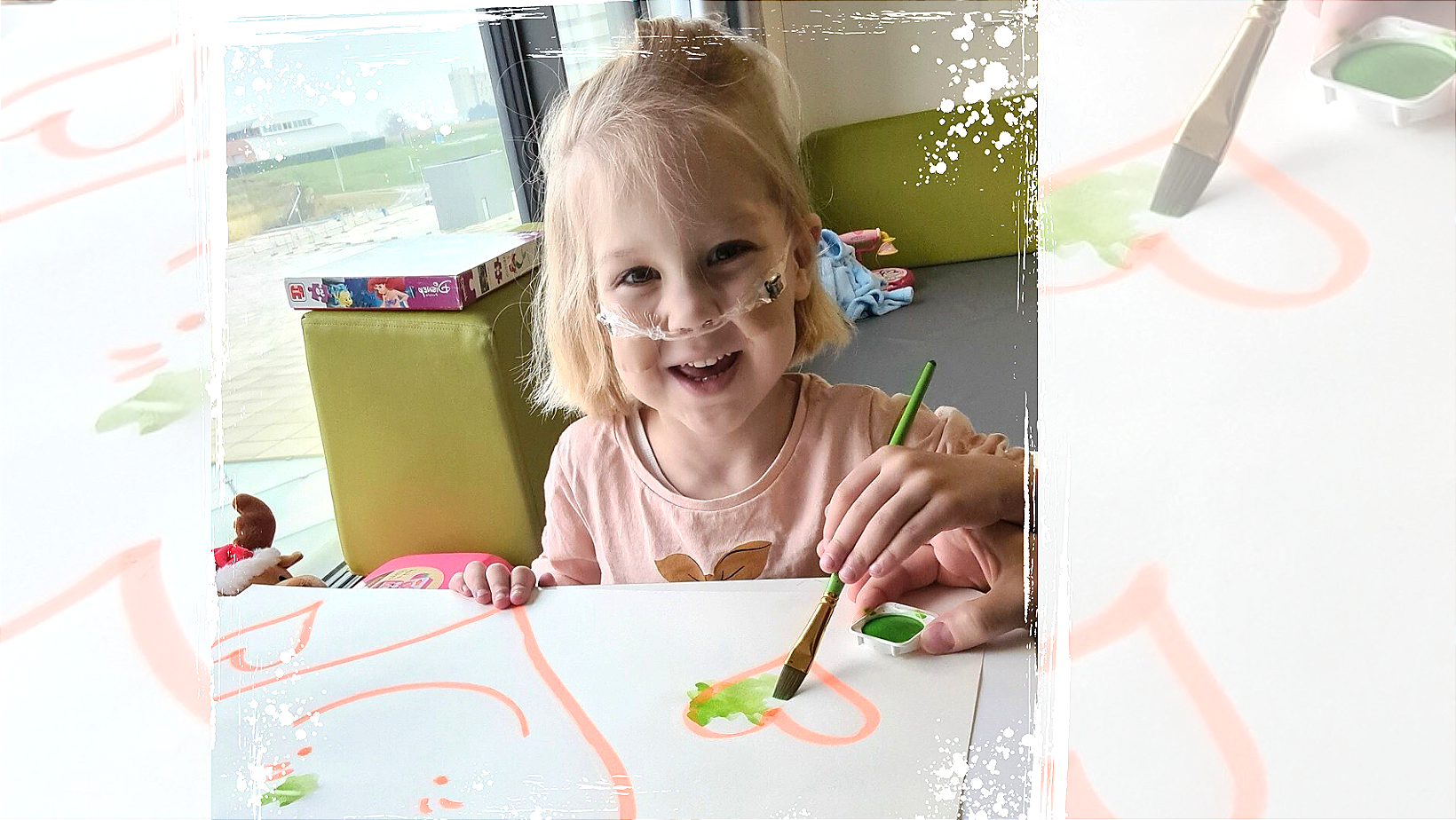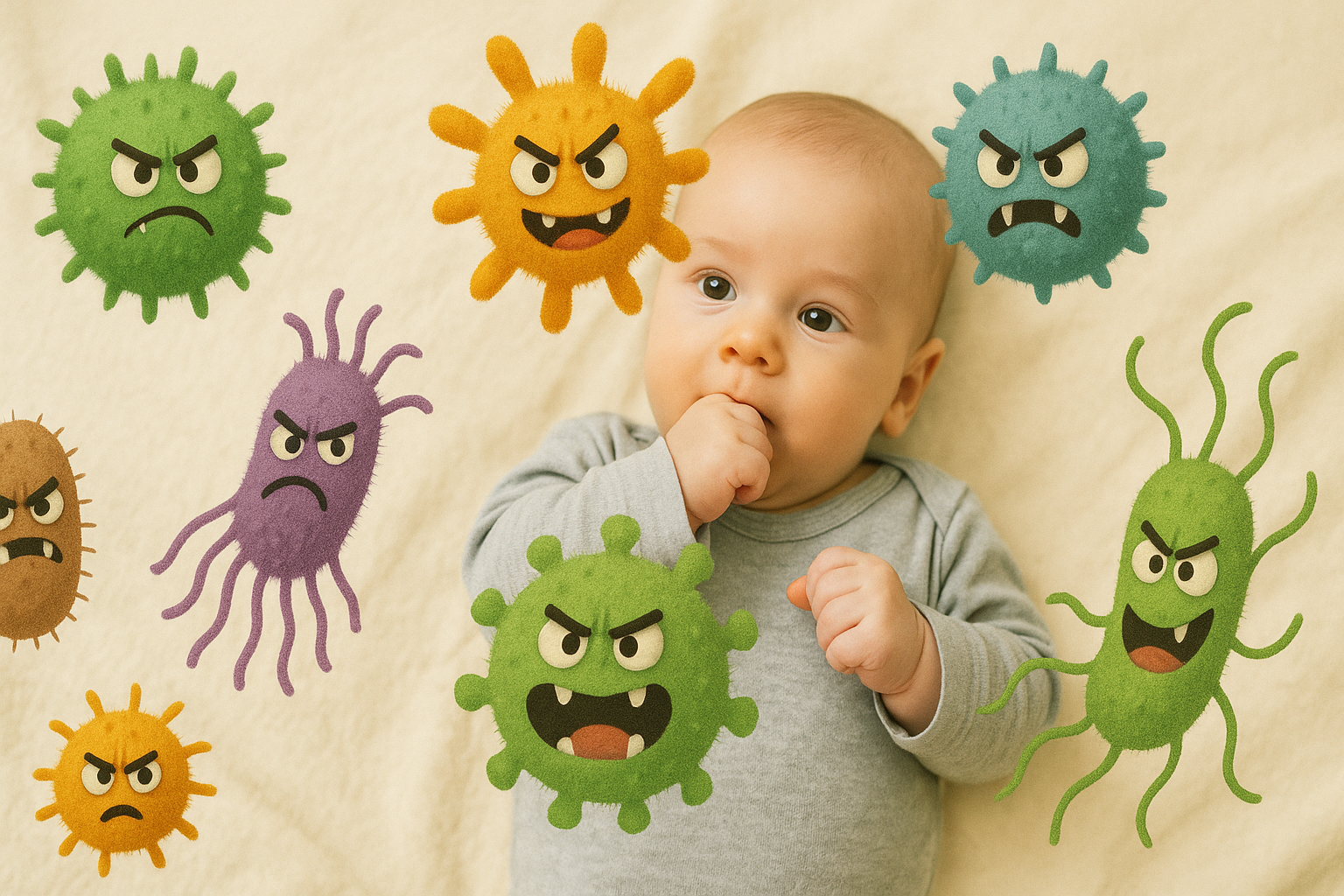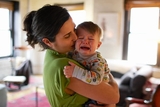OCTOBER IS FOR PREVENTION: RSV, Flu, and COVID Vaccines - with MUDr. Martin Záhorec, PhD.
RSV, flu, COVID — three viruses that can turn an ordinary winter into a high-stakes season for medically fragile kids. What has changed in recent years, and how can families prepare? A look at prevention through a parent’s eyes and our expert's answers.

It's not easy telling family members to stay away when all they want to do is visit the newborn. Their intentions are good. But they don't see what a newly become mother sees.
I remember that strange mix of horror, relief, and happiness when we finally left the hospital after seven months. Seven months tucked inside meticulously cleaned rooms, surrounded by the smell of disinfectants and professionals ready to jump in at any minute of the day.
Have you ever stopped to think how a hospital can be both the place you want to run away from as far as possible, and also the safest place you'll ever find yourself in? Inside those walls, our baby girl's life was being saved. Outside, she was always at some kind of risk.
So, as soon as viral season started, I had to sharpen my mama bear claws and start fending off visitors - both visible and microscopic. At our home, you could find disinfectant almost in every drawer and on every shelf. Honestly, sometimes I'd catch myself waving my hand through the air, as if shooting away a fly, imagining mean-looking little furry round viruses floating happily around, ready to dock on my baby's hands. And the moment she'd suck on them, they'd anchor themselves inside her nose or mouth.

It might sound funny — and I admit, I often laughed about it with my fellow baby-mom friends. We'd make fun of ourselves and of all the apologetic explanations we had to give to family members with "just a little cough." But... when the social etiquette defining moms like me as "overly cautious" (and what I mean is "complicated") quieted down, the silent fear stayed. And when a high-risk child is part of the equation... well, the stakes become too high.
RSV - The Virus That Shaped Our Early Years
Every October, two fears walk hand in hand: our 7-year-old with a single ventricle heart catching a virus, and the doctor's appointment to her seasonal shots. One carries the risk of hospital stays and oxygen support. The other involves a lot of heartbreaking tears and a battle against the needle. I pick the lesser of two evils. Vaccination wins.
In babies born prematurely, or those with heart, lung, or neuromuscular disease, RSV can lead to severe respiratory illness or pneumonia, sometimes life-threatening. RSV infection in infancy may also increase the risk of developing asthma later in childhood.
(Children's Hospital of Philadelphia)
In the early years of our daughter's life, RSV prevention was actually quite simple. During the first two winters, we came to the hospital once a month for her regular shot of antibodies. The medicine used was called Synagis (palivizumab) — a monthly injection that protected her during the viral season.
At the end of 2025, Synagis was discontinued in many countries. It was replaced by new long-acting anti-RSV monoclonal antibodies, which are considered both simpler and more effective.
Today, nirsevimab is used for newborns and infants during their first RSV season in many European countries. A single intramuscular dose provides protection for about five months — roughly the length of the season. Clesrovimab, a newer antibody, works on the same principle and is now being introduced in some countries. However, these are not vaccines — they don't teach the immune system how to protect itself. They are ready-made antibodies that neutralize RSV before it can enter, providing instant passive protection. The best timing is shortly before the season starts or within the first week after birth if a baby is born during the season.
Another new option available is a vaccine given to pregnant women between 32 and 36 weeks of gestation to protect their infants from severe RSV disease during the first six months of life. The vaccine helps the mother develop antibodies that are then passed to the baby through the placenta. Studies show it can reduce the risk of severe illness from RSV in infants by about 70%. In Slovakia, it is currently not covered by health insurance.
(MUDr. Martin Záhorec, PhD., pediatric cardiologist, Bratislava, Slovakia)
For certain high-risk groups, palivizumab or nirsevimab can also be given during the second RSV season, up to 24 months of age. But, this is an exception discussed with the doctor. Congenital heart disease alone doesn’t qualify for second-season dosing, but if a child receives nirsevimab and then undergoes cardiac surgery with cardiopulmonary bypass, an additional dose is recommended afterward.

COVID-19 — Still Part of the Story
By the time the world learned to live with COVID, things got more complicated. New vaccines, shifting recommendations, studies piling up faster than parents could read them. And layered on top of our usual worries was something none of us fully understood yet: myocarditis.
In recent years, we’ve been seeing more small children admitted with myocarditis (an inflammation of the heart muscle) or dilated cardiomyopathy (an abnormally large heart which is unable to pump the blood effectively) than before the pandemic. It’s difficult to say what exactly is driving this trend — whether it’s related to COVID infections, post-COVID complications, or other factors. The situation is worrisome, and we still don’t fully understand the underlying causes. In Slovakia and across the EU, I am not aware of the official recommendations for the use of the COVID-19 vaccine for the 2025/26 season in children. On the other hand, the American Academy of Pediatrics recommends the 2025/26 COVID-19 vaccine for all infants and children aged 6 through 23 months, as well as for high-risk groups among older children (2-18 years), including those with congenital heart disease.
(MUDr. Martin Záhorec, PhD., pediatric cardiologist, Bratislava, Slovakia)
Guidance for vaccinating children against COVID is still evolving. The current model is “shared clinical decision-making” for children aged 6 months to 17 years. This means the vaccine is available, but the decision should be made together with the clinician, weighing benefits and risks for each individual child.
For children with CHD, many European immunization programs still list them as priority groups. Specialty literature even recommends vaccinating before planned surgeries (ideally at least 2 weeks beforehand).
Research shows that children with CHD hospitalized for COVID-19 face higher risks — more complications, longer hospital stays, and more intense treatment. COVID infection itself can affect the heart (e.g., myocarditis, arrhythmias), adding strain to an already vulnerable system. The risk of vaccine-related myocarditis remains low, and in many analyses, the risk of myocarditis from COVID is higher than from the vaccine, especially in adolescents.
So... In our family, we've decided not to vaccinate our 7-year-old against COVID for now, but we're clear-eyed about the evidence. It's a decision we've made, balancing her health and evolving data.

Influenza - The Reliable Visitor
And then, there's the flu — the virus that returns every year, quietly, reliably, sometimes underestimated. For families like ours, it's never "just a cold." It's the one vaccine appointment we never skip.
(Children's Hospital of Philadelphia)
The professional recommendation is clear: everyone from 6 months of age should be vaccinated against flu every year. The first time is special: if the child is between 6 months and 8 years and hasn't had at least two flu vaccine doses before, they'll need two doses, four weeks apart.
For babies and children with congenital heart disease, flu can be far more than just a fever and a few sniffles — it can quickly turn into a serious respiratory or cardiac complication. When siblings and parents are also vaccinated, we create a protective ‘cocoon’ around the most vulnerable child, lowering the chance that the virus will even enter the household. There is also a new option of a nasal spray flu vaccine, available for many children, offering a painless and needle-free way to get protected. This vaccine uses a weakened form of the live flu virus and is approved for children over 2 years of age.
(MUDr. Martin Záhorec, PhD., pediatric cardiologist, Bratislava, Slovakia)
Personally, we make sure everyone in our family — grandparents, aunts, uncles — is vaccinated. Before visiting anyone, we check that all are healthy. It's trickier when people want to visit us. I often gave in to guilt when denying visits, convincing myself I was exaggerating. So I'd compromise: shoes off, hands washed, disinfected, no kissing, no touching the baby's face or hands. I'd air our home before and after, prepared for the worst, hoping for the best.

The Inner Voice of a (Over)Protective Parent
In the end, in all these years, we were hospitalized due to a viral infection only once. So maybe the worst scenarios really were my inner fears fighting each other — the over-worrier vs. the people-pleaser.
Even as I write this, I roll my eyes, thinking I'm too dramatic. But here's the fact I've lived with since bringing our seven-month-old home from the hospital: respiratory viral infections can be very harmful to a child with congenital heart disease, especially in early childhood.
And if that means a few extra boundaries, some awkward conversations, and a yearly calendar full of preventive shots — then so be it.
Medical Disclaimer
This article is for informational or educational purposes only. It does not substitute professional medical advice, diagnosis or treatment. Always seek the advice of a physician or other qualified health provider.
References
- Children’s Hospital of Philadelphia (CHOP) – Vaccine Education Center. Influenza: The Disease & the Vaccine.
- Children’s Hospital of Philadelphia (CHOP) – Influenza (Flu) in Children.
- Children’s Hospital of Philadelphia (CHOP) – Be a Flu Fighter! Navigating Flu Season.
- Children’s Hospital of Philadelphia (CHOP) – Respiratory Syncytial Virus (RSV).
- European Medicines Agency (EMA) – Beyfortus (nirsevimab) – EPAR.
- European Medicines Agency (EMA) – Enflonsia (clesrovimab) – EPAR.
- Centers for Disease Control and Prevention (CDC). Interim Clinical Considerations for Use of COVID-19 Vaccines.
- Centers for Disease Control and Prevention (CDC). Stay Up to Date with COVID-19 Vaccines.
- Centers for Disease Control and Prevention (CDC). COVID-19 Vaccination Schedule: 6 Months and Older (PDF).
- WHO / European Centre for Disease Prevention and Control (ECDC). Vaccination of high-risk groups.
- BMJ / BMC Pediatrics – Children with congenital heart disease hospitalized with COVID-19.
- Cambridge University Press – AEPC Position Paper. COVID-19 FAQs in Pediatric and Congenital Cardiology.
- Sage Journals – Perioperative COVID-19 Vaccination Guidance for Pediatric Congenital Cardiac Surgery.


